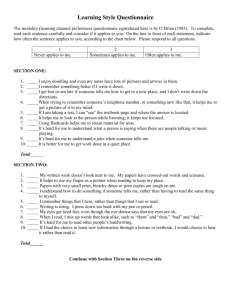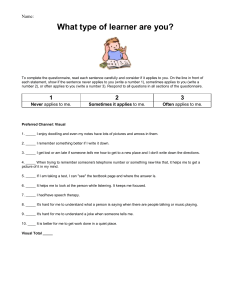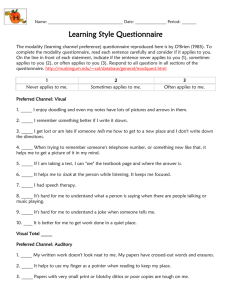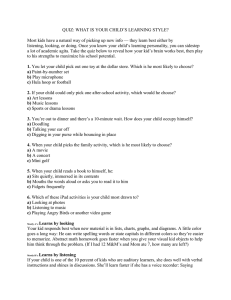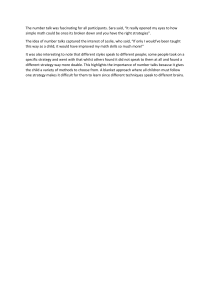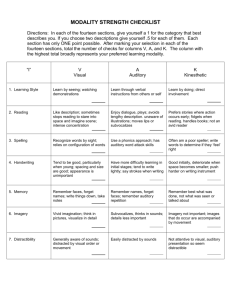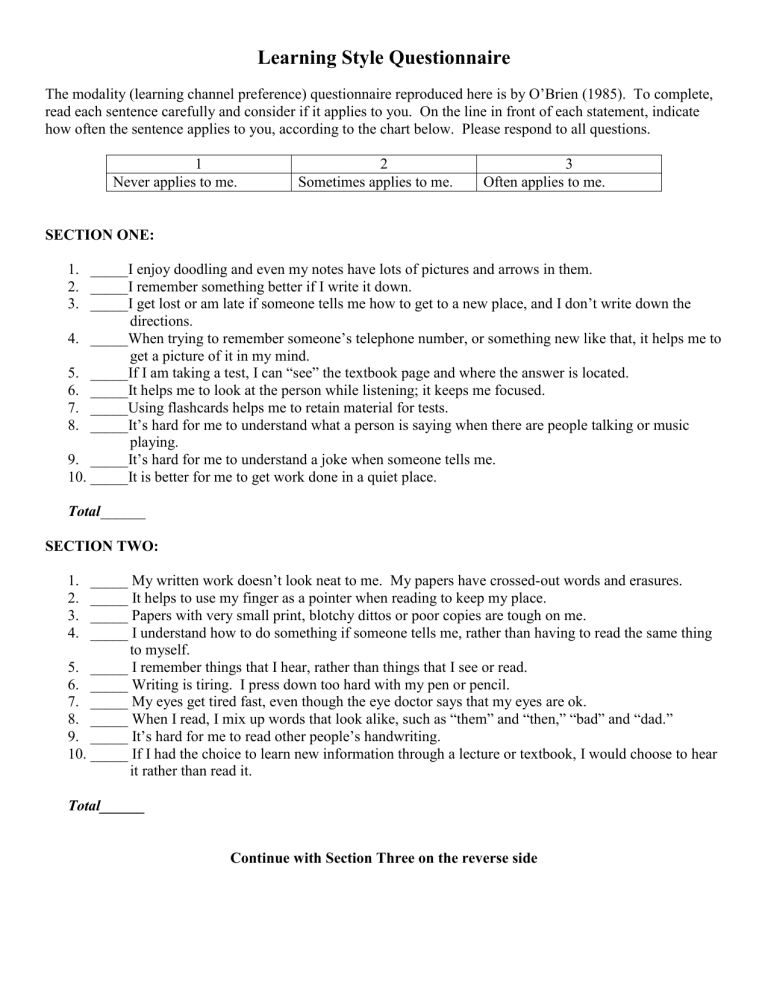
Learning Style Questionnaire The modality (learning channel preference) questionnaire reproduced here is by O’Brien (1985). To complete, read each sentence carefully and consider if it applies to you. On the line in front of each statement, indicate how often the sentence applies to you, according to the chart below. Please respond to all questions. 1 Never applies to me. 2 Sometimes applies to me. 3 Often applies to me. SECTION ONE: 1. _____I enjoy doodling and even my notes have lots of pictures and arrows in them. 2. _____I remember something better if I write it down. 3. _____I get lost or am late if someone tells me how to get to a new place, and I don’t write down the directions. 4. _____When trying to remember someone’s telephone number, or something new like that, it helps me to get a picture of it in my mind. 5. _____If I am taking a test, I can “see” the textbook page and where the answer is located. 6. _____It helps me to look at the person while listening; it keeps me focused. 7. _____Using flashcards helps me to retain material for tests. 8. _____It’s hard for me to understand what a person is saying when there are people talking or music playing. 9. _____It’s hard for me to understand a joke when someone tells me. 10. _____It is better for me to get work done in a quiet place. Total______ SECTION TWO: _____ My written work doesn’t look neat to me. My papers have crossed-out words and erasures. _____ It helps to use my finger as a pointer when reading to keep my place. _____ Papers with very small print, blotchy dittos or poor copies are tough on me. _____ I understand how to do something if someone tells me, rather than having to read the same thing to myself. 5. _____ I remember things that I hear, rather than things that I see or read. 6. _____ Writing is tiring. I press down too hard with my pen or pencil. 7. _____ My eyes get tired fast, even though the eye doctor says that my eyes are ok. 8. _____ When I read, I mix up words that look alike, such as “them” and “then,” “bad” and “dad.” 9. _____ It’s hard for me to read other people’s handwriting. 10. _____ If I had the choice to learn new information through a lecture or textbook, I would choose to hear it rather than read it. 1. 2. 3. 4. Total______ Continue with Section Three on the reverse side SECTION THREE: _____ I don’t like to read directions; I’d rather just start doing. _____ I learn best when I am shown how to do something, and I have the opportunity to do it. _____ Studying at a desk is not for me. _____ I tend to solve problems through a more trial-and-error approach, rather than from a step-by-step method. 5. _____ Before I follow directions, it helps me to see someone else do it first. 6. _____ I find myself needing frequent breaks while studying. 7. _____ I am not skilled in giving verbal explanations or directions. 8. _____ I do not become easily lost, even in strange surroundings. 9. _____ I think better when I have the freedom to move around. 10. _____ When I can’t think of a specific word, I’ll use my hands a lot and call something a “what-cha-macall-it” or a “thing-a-ma-jig.” 1. 2. 3. 4. Total______ SCORING: Now, add up the scores for each of the three sections and record below. The maximum score in any section is 30 and the minimum score is 10. Note the preference next to each section. Section One score: _____(Visual) Section Two score: ______(Auditory) Section Three score: ______(Kinesthetic) EVALUATING THE LEARNING STYLE QUESTIONNAIRE The modality type with the highest score indicates your preferred learning channel. The higher the score, the stronger the preference. If you have relatively high scores in two or more sections, you probably have more than one strength. If the scores in the sections are roughly equal, you probably do not have a preferred learning channel; you are a multi-sensory learner. The following table summarizes the observable characteristic indicative of the three learning styles. It provides an informal means of assessing your preferred approach to learning. MODALITY VISUAL AUDISTORY PREFERRED LEARNING STYLE Learns by seeing or watching demonstrations SPELLING Recognizes words by sight; relies on configurations of words. Likes description; sometimes stops reading to stare into space and imagine scene; intense concentration. Tends to be a good, particularly when young; spacing and size are good; appearance is important. Learns through verbal instructions from self or others. Uses a phonics approach has auditory word attack skills. Enjoys dialogue and plays; avoids lengthy descriptions; unaware of illustrations; moves lips or sub-vocalizes. Has more difficulty learning in initial stages; tends to write lightly. READING HANDWRITING MEMORY IMAGERY Remember faces, but forgets names; writes things down; takes notes. Vivid imagination; thinks in pictures; visualizes in detail. DISTRACTABILITY Unaware of sounds; distracted by movement. PROBLEM SOLVING RESPONSE TO PERIODS OF INACTIVITY RESPONSE TO NEW SITUATIONS Remembers names, but forgets faces; remembers by auditory repetition. Sub-vocalizes; imagines things in sounds; details are less important. Easily distracted by sounds. Deliberate; plans in advance; organizes thoughts by writing them; lists problems. Stares or doodles; finds something. Talks problems out; tries solutions verbally or subvocally; talks self through problems. Hums, talks to self, or talks to others. Looks around or examines structure. Talks about situation; discusses pros and cons of what to do. KINESTHETIC (Hands-on) Learns by doing and direct involvement. Often is a poor speller; writes words to determine if they “feel” right. Prefers stories where action occurs early; fidgets while reading; not an avid reader. Good initially, but deteriorates when space becomes smaller; pushes harder on writing instrument. Remembers best what was done, but not what was seen or talked about. Imagery not important; images that do occur are accompanied by movement. Not attentive to visual or auditory presentation so may seem distracted. Attacks problem physically; impulsive; often selects solution involving greatest activity. Fidgets or finds reasons to move. Tries things out; touches, feels or manipulates.
